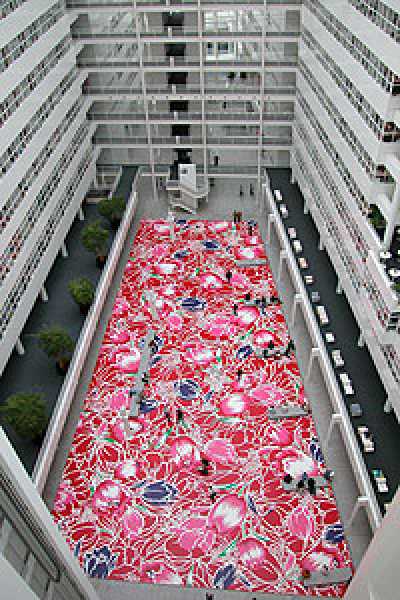Foto: Stroom Den Haag
Michael Lin, 'Tulpenvloer Atrium', 2002
In the summer of 2002, a spectacular painted floral floor was installed in the Atrium of The Hague City Hall by Taiwanese artist Michael Lin. The artwork had the gigantic size of 1100 m2 and was constructed from no less than 370 hand-painted wooden panels. The bright red floor with its colorful motifs inspired by traditional Asian floral patterns contrasted beautifully with the clean, white architecture of the Richard Meier-designed building.
With his enormous floral floor, Michael Lin (b. 1964) deliberately created a functional work of art. The public was allowed to walk across it and organize various activities on it, such as performances, receptions and even exhibitions. The threshold fear of contemporary art was literally removed. Moreover, the unique location of the Atrium made it possible to view the impressive painting from above.
Michael Lin has been an in-demand artist in recent years. His work has been shown at the Venice Biennale, the Istanbul Biennale, the Municipal Museum of Contemporary Art (SMAK) in Ghent and the Palais de Tokyo in Paris, among others. In all of these places, Michael Lin chooses to present his work in a location that is in common use. He prefers the library, the cafeteria, the museum store or the main hall where people walk in and out, to the solemn museum hall.
The production was a huge job and had started several months in advance in the project space of the Royal Academy of Art in The Hague. Michael Lin was assisted by more than 70 students of the Royal Academy and by 15 professional visual artists. Ornate floral motifs were projected onto the wooden panels, after which the panels were hand-painted one by one and given protective coats of varnish.
Michael Lin was invited on the advice of Stroom hcbk as part of a cultural exchange between the Taiwanese capital Taipei and the municipality of The Hague. The Hague poet Erik Lindner had already been a guest at a poetry festival in Taipei in the fall of 2001. The Michael Lin project was carried out in close cooperation with Stichting Atrium.
The project was financially made possible in part by Stroom hcbk, Stichting Atrium, Stichting Doen, the municipality of The Hague, Casema Cultuur Fonds, Fonds 1818, The Ministry of Foreign Affairs of Taiwan R.O.C., the Royal Academy of Arts The Hague



